Hydrogen Embrittlement of CoCrFeMnNi High-Entropy Alloy Compared with 304 and IN718 Alloys
Abstract
:1. Introduction
2. Experimental Materials and Methods
2.1. Materials
2.2. Microstructural Characterization
2.3. Electrochemical Hydrogen Pre-Charging
2.4. Slow Strain Rate Tensile Test
2.5. Fracture Surface Observation
3. Results
3.1. Initial Microstructure
3.2. Tensile Mechanical Properties
3.3. Fracture Surface
3.4. Microstructural Comparison of Hydrogen-Uncharged and -Charged Samples of HEA
4. Discussion
4.1. Hydrogen Diffusivity of CoCrFeMnNi, 304SS, and IN718 Alloy
4.2. Failure Mechanisms of Hydrogenated CoCrFeMnNi, 304SS and IN718 Alloy
5. Conclusions
- CoCrFeMnNi exhibits the lowest susceptibility to HE, followed by 304SS and then IN718 alloy, when hydrogen charging parameters are 1.79 mA cm−2 for 24 h and 48 h, and 179 mA cm−2 for 2 h. The result indicates that HEAs can potentially be regarded as a HE-resistance alloy for particular hydrogen-containing conditions.
- Regardless of the hydrogen charging conditions in this study, the fracture strain of 304SS and IN718 alloy decreases in the presence of hydrogen, whereas the effect of hydrogen on ductility of HEA depends on hydrogen charging time. At short charging time (24 h), a hydrogen-enhanced twin formation mechanism dominates, improving the material ductility. Meanwhile, the HEDE mechanism is responsible for the reduction in the fracture strain at long charging time (48 h).
- Based on the combination of brittle zone observations and the hydrogen diffusion modeling, the hydrogen diffusion coefficients are estimated to be 1.54 × 10−16 m2 s−1 for CoCrFeMnNi, 3.35 × 10−16 m2 s−1 for IN718 alloy and 6.09 × 10−16 m2 s−1 for 304SS, respectively.
- The number of nano twins (2.71) and the width of SF bundles (5.77 nm) in the hydrogen-assisted brittle zone is greater than in uncharged samples (2.57 and 5.02 nm). It clearly demonstrates that the presence of hydrogen promotes the formation of stacking faults and twins in CoCrFeMnNi alloy.
Author Contributions
Funding
Data Availability Statement
Acknowledgments
Conflicts of Interest
References
- Yeh, J.W.; Chen, Y.L.; Lin, S.J.; Chen, S.K. High-entropy alloys–a new era of exploitation. In Materials Science Forum; Trans Tech Publications: Zurich, Switzerland, 2007; pp. 1–9. [Google Scholar]
- Miracle, D.B.; Senkov, O.N. A critical review of high entropy alloys and related concepts. Acta Mater. 2017, 122, 448–511. [Google Scholar] [CrossRef] [Green Version]
- Tsai, M.-H.; Yeh, J.-W. High-entropy alloys: A critical review. Mater. Res. Lett. 2014, 2, 107–123. [Google Scholar] [CrossRef]
- Wang, Z.; Wang, C.; Zhao, Y.-L.; Hsu, Y.-C.; Li, C.-L.; Kai, J.-J.; Liu, C.-T.; Hsueh, C.-H. High hardness and fatigue resistance of CoCrFeMnNi high entropy alloy films with ultrahigh-density nanotwins. Int. J. Plast. 2020, 131, 102726. [Google Scholar] [CrossRef]
- Cai, Y.; Wang, G.; Ma, Y.; Cao, Z.; Meng, X. High hardness dual-phase high entropy alloy thin films produced by interface alloying. Scr. Mater. 2019, 162, 281–285. [Google Scholar] [CrossRef]
- Nene, S.S.; Frank, M.; Liu, K.; Mishra, R.; McWilliams, B.; Cho, K. Extremely high strength and work hardening ability in a metastable high entropy alloy. Sci. Rep. 2018, 8, 9920. [Google Scholar] [CrossRef]
- Lei, Z.; Liu, X.; Wu, Y.; Wang, H.; Jiang, S.; Wang, S.; Hui, X.; Wu, Y.; Gault, B.; Kontis, P. Enhanced strength and ductility in a high-entropy alloy via ordered oxygen complexes. Nature 2018, 563, 546–550. [Google Scholar] [CrossRef]
- Eremin, E.; Yurov, V.; Guchenko, S. Wear resistance and tribological properties of high entropy coatings CrNiTiZrCu. Eurasian Phys. Tech. J. 2020, 17, 33. [Google Scholar] [CrossRef]
- Jin, B.; Zhang, N.; Yu, H.; Hao, D.; Ma, Y. AlxCoCrFeNiSi high entropy alloy coatings with high microhardness and improved wear resistance. Surf. Coat. Technol. 2020, 402, 126328. [Google Scholar] [CrossRef]
- Nene, S.; Frank, M.; Liu, K.; Sinha, S.; Mishra, R.; McWilliams, B.; Cho, K. Corrosion-resistant high entropy alloy with high strength and ductility. Scr. Mater. 2019, 166, 168–172. [Google Scholar] [CrossRef]
- Luo, H.; Sohn, S.S.; Lu, W.; Li, L.; Li, X.; Soundararajan, C.K.; Krieger, W.; Li, Z.; Raabe, D. A strong and ductile medium-entropy alloy resists hydrogen embrittlement and corrosion. Nat. Commun. 2020, 11, 3081. [Google Scholar] [CrossRef]
- Zhao, Y.; Lee, D.-H.; Seok, M.-Y.; Lee, J.-A.; Phaniraj, M.; Suh, J.-Y.; Ha, H.-Y.; Kim, J.-Y.; Ramamurty, U.; Jang, J.-I. Resistance of CoCrFeMnNi high-entropy alloy to gaseous hydrogen embrittlement. Scr. Mater. 2017, 135, 54–58. [Google Scholar] [CrossRef]
- Pu, Z.; Chen, Y.; Dai, L. Strong resistance to hydrogen embrittlement of high-entropy alloy. Mater. Sci. Eng. A 2018, 736, 156–166. [Google Scholar] [CrossRef]
- Lu, C.; Niu, L.; Chen, N.; Jin, K.; Yang, T.; Xiu, P.; Zhang, Y.; Gao, F.; Bei, H.; Shi, S. Enhancing radiation tolerance by controlling defect mobility and migration pathways in multicomponent single-phase alloys. Nat. Commun. 2016, 7, 13564. [Google Scholar] [CrossRef]
- Lin, Y.; Yang, T.; Lang, L.; Shan, C.; Deng, H.; Hu, W.; Gao, F. Enhanced radiation tolerance of the Ni-Co-Cr-Fe high-entropy alloy as revealed from primary damage. Acta Mater. 2020, 196, 133–143. [Google Scholar] [CrossRef]
- Liu, J.; Guo, X.; Lin, Q.; He, Z.; An, X.; Li, L.; Liaw, P.K.; Liao, X.; Yu, L.; Lin, J. Excellent ductility and serration feature of metastable CoCrFeNi high-entropy alloy at extremely low temperatures. Sci. China Mater. 2019, 62, 853–863. [Google Scholar] [CrossRef] [Green Version]
- Gludovatz, B.; Hohenwarter, A.; Catoor, D.; Chang, E.H.; George, E.P.; Ritchie, R.O. A fracture-resistant high-entropy alloy for cryogenic applications. Science 2014, 345, 1153–1158. [Google Scholar] [CrossRef] [Green Version]
- Li, X.; Ma, X.; Zhang, J.; Akiyama, E.; Wang, Y.; Song, X. Review of Hydrogen Embrittlement in Metals: Hydrogen Diffusion, Hydrogen Characterization, Hydrogen Embrittlement Mechanism and Prevention. Acta Metall. Sin. (Engl. Lett.) 2020, 33, 759–773. [Google Scholar] [CrossRef]
- Luo, H.; Li, Z.; Lu, W.; Ponge, D.; Raabe, D. Hydrogen embrittlement of an interstitial equimolar high-entropy alloy. Corros. Sci. 2018, 136, 403–408. [Google Scholar] [CrossRef]
- Koyama, M.; Ichii, K.; Tsuzaki, K. Grain refinement effect on hydrogen embrittlement resistance of an equiatomic CoCrFeMnNi high-entropy alloy. Int. J. Hydrogen Energy 2019, 44, 17163–17167. [Google Scholar] [CrossRef]
- Zhao, Y.; Lee, D.-H.; Kim, W.-J.; Seok, M.-Y.; Kim, J.-Y.; Han, H.N.; Suh, J.-Y.; Ramamurty, U.; Jang, J.-I. Influence of pre-strain on the gaseous hydrogen embrittlement resistance of a high-entropy alloy. Mater. Sci. Eng. A 2018, 718, 43–47. [Google Scholar] [CrossRef]
- Kwon, Y.J.; Won, J.W.; Park, S.H.; Lee, J.H.; Lim, K.R.; Na, Y.S.; Lee, C.S. Ultrahigh-strength CoCrFeMnNi high-entropy alloy wire rod with excellent resistance to hydrogen embrittlement. Mater. Sci. Eng. A 2018, 732, 105–111. [Google Scholar] [CrossRef]
- Lee, J.; Park, H.; Kim, M.; Kim, H.-J.; Suh, J.-Y.; Kang, N. Role of hydrogen and temperature in hydrogen embrittlement of equimolar CoCrFeMnNi high-entropy alloy. Met. Mater. Int. 2021, 27, 166–174. [Google Scholar] [CrossRef]
- Kim, Y.-K.; Suh, J.-Y.; Lee, K.-A. Effect of gaseous hydrogen embrittlement on the mechanical properties of additively manufactured CrMnFeCoNi high-entropy alloy strengthened by in-situ formed oxide. Mater. Sci. Eng. A 2020, 796, 140039. [Google Scholar] [CrossRef]
- Ichii, K.; Koyama, M.; Tasan, C.C.; Tsuzaki, K. Comparative study of hydrogen embrittlement in stable and metastable high-entropy alloys. Scr. Mater. 2018, 150, 74–77. [Google Scholar] [CrossRef]
- Wang, H.; Koyama, M.; Hojo, T.; Akiyama, E. Hydrogen embrittlement and associated surface crack growth in fine-grained equiatomic CoCrFeMnNi high-entropy alloys with different annealing temperatures evaluated by tensile testing under in situ hydrogen charging. Int. J. Hydrogen Energy 2021, 46, 33028–33038. [Google Scholar] [CrossRef]
- Bertsch, K.; Nygren, K.; Wang, S.; Bei, H.; Nagao, A. Hydrogen-enhanced compatibility constraint for intergranular failure in FCC FeNiCoCrMn high-entropy alloy. Corros. Sci. 2021, 184, 109407. [Google Scholar] [CrossRef]
- Lu, X.; Wang, D.; Li, Z.; Deng, Y.; Barnoush, A. Hydrogen susceptibility of an interstitial equimolar high-entropy alloy revealed by in-situ electrochemical microcantilever bending test. Mater. Sci. Eng. A 2019, 762, 138114. [Google Scholar] [CrossRef]
- Nygren, K.; Bertsch, K.; Wang, S.; Bei, H.; Nagao, A.; Robertson, I. Hydrogen embrittlement in compositionally complex FeNiCoCrMn FCC solid solution alloy. Curr. Opin. Solid State Mater. Sci. 2018, 22, 1–7. [Google Scholar] [CrossRef]
- Wan, D.; Guan, S.; Wang, D.; Lu, X.; Ma, J. Hydrogen embrittlement of additively manufactured AlCoCrFeNi2. 1 eutectic high-entropy alloy. Corros. Sci. 2022, 195, 110007. [Google Scholar] [CrossRef]
- Zhu, T.; Zhong, Z.; Ren, X.; Song, Y.; Ye, F.; Wang, Q.; Ngan, A.H.; Wang, B.; Cao, X.; Xu, Q. Influence of hydrogen behaviors on tensile properties of equiatomic FeCrNiMnCo high-entropy alloy. J. Alloys Compd. 2022, 892, 162260. [Google Scholar] [CrossRef]
- Luo, H.; Zhao, B.; Pan, Z.; Fu, Y.; Li, X. Hydrogen induced microstructure evolution and cracking mechanism in a metastable dual-phase high-entropy alloy. Mater. Sci. Eng. A 2021, 819, 141490. [Google Scholar] [CrossRef]
- Xie, Z.-C.; Li, C.; Wang, H.-Y.; Lu, C.; Dai, L.-H. Hydrogen induced slowdown of spallation in high entropy alloy under shock loading. Int. J. Plast. 2021, 139, 102944. [Google Scholar] [CrossRef]
- Li, X.; Feng, Z.; Song, X.; Wang, Y.; Zhang, Y. Effect of hydrogen charging time on hydrogen embrittlement of CoCrFeMnNi high-entropy alloy. Corros. Sci. 2021, 198, 110073. [Google Scholar] [CrossRef]
- Luo, H.; Li, Z.; Raabe, D. Hydrogen enhances strength and ductility of an equiatomic high-entropy alloy. Sci. Rep. 2017, 7, 9892. [Google Scholar] [CrossRef] [Green Version]
- Wang, Y.; Wu, X.; Li, X.; Wu, W.; Gong, J. Combined effects of prior plastic deformation and sensitization on hydrogen embrittlement of 304 austenitic stainless steel. Int. J. Hydrogen Energy 2019, 44, 7014–7031. [Google Scholar] [CrossRef]
- Li, X.; Zhang, J.; Fu, Q.; Akiyama, E.; Song, X.; Wang, Y.; Li, Q.; Zou, N. Tensile mechanical properties and fracture behaviors of nickel-based superalloy 718 in the presence of hydrogen. Int. J. Hydrogen Energy 2018, 43, 20118–20132. [Google Scholar] [CrossRef]
- Li, X.; Zhang, J.; Wang, Y.; Li, B.; Zhang, P.; Song, X. Effect of cathodic hydrogen-charging current density on mechanical properties of prestrained high strength steels. Mater. Sci. Eng. A 2015, 641, 45–53. [Google Scholar] [CrossRef]
- Nguyen, T.T.; Heo, H.M.; Park, J.; Nahm, S.H.; Beak, U.B. Stress concentration affecting hydrogen-assisted crack in API X70 pipeline base and weld steel under hydrogen/natural gas mixture. Eng. Fail. Anal. 2021, 122, 105242. [Google Scholar] [CrossRef]
- Momotani, Y.; Shibata, A.; Terada, D.; Tsuji, N. Effect of strain rate on hydrogen embrittlement in low-carbon martensitic steel. Int. J. Hydrogen Energy 2017, 42, 3371–3379. [Google Scholar] [CrossRef]
- Zaddach, A.; Niu, C.; Koch, C.; Irving, D. Mechanical properties and stacking fault energies of NiFeCrCoMn high-entropy alloy. JOM 2013, 65, 1780–1789. [Google Scholar] [CrossRef]
- Gonzalez, B.; Murr, L.; Valerio, O.; Esquivel, E.; Lopez, H. Microbands and microtwins associated with impact craters in copper and brass targets: The role of stacking fault energy. Mater. Charact. 2002, 49, 359–366. [Google Scholar] [CrossRef]
- Kumar, N.; Ying, Q.; Nie, X.; Mishra, R.; Tang, Z.; Liaw, P.; Brennan, R.; Doherty, K.; Cho, K. High strain-rate compressive deformation behavior of the Al0. 1CrFeCoNi high entropy alloy. Mater. Des. 2015, 86, 598–602. [Google Scholar] [CrossRef]
- Fournier, D.; Pineau, A. Low cycle fatigue behavior of Inconel 718 at 298 K and 823 K. Metall. Trans. A 1977, 8, 1095–1105. [Google Scholar] [CrossRef]
- You, X.; Tan, Y.; Shi, S.; Yang, J.-M.; Wang, Y.; Li, J.; You, Q. Effect of solution heat treatment on the precipitation behavior and strengthening mechanisms of electron beam smelted Inconel 718 superalloy. Mater. Sci. Eng. A 2017, 689, 257–268. [Google Scholar] [CrossRef]
- Panchenko, M.Y.; Melnikov, E.; Mikhno, A.; Maier, G.; Astafurov, S.; Moskvina, V.; Reunova, K.; Galchenko, N.; Astafurova, E. The influence of intergranular and interphase boundaries and δ-ferrite volume fraction on hydrogen embrittlement of high-nitrogen steel. Int. J. Hydrogen Energy 2021, 46, 30510–30522. [Google Scholar] [CrossRef]
- Zhang, S.; Liu, M.; Luo, Y.; Wang, L.; Wang, Z.; Wang, Z.; Li, F.; Wang, X. Immunity of Al0. 25CoCrFeNi high-entropy alloy to hydrogen embrittlement. Mater. Sci. Eng. A 2021, 821, 141590. [Google Scholar] [CrossRef]
- Zhao, Y.; Park, J.-M.; Lee, D.-H.; Song, E.J.; Suh, J.-Y.; Ramamurty, U.; Jang, J.-I. Influences of hydrogen charging method on the hydrogen distribution and nanomechanical properties of face-centered cubic high-entropy alloy: A comparative study. Scr. Mater. 2019, 168, 76–80. [Google Scholar] [CrossRef]
- Yoo, J.; Jo, M.C.; Jo, M.C.; Kim, S.; Kim, S.-H.; Oh, J.; Sohn, S.S.; Lee, S. Effects of solid solution and grain-boundary segregation of Mo on hydrogen embrittlement in 32MnB5 hot-stamping steels. Acta Mater. 2021, 207, 116661. [Google Scholar] [CrossRef]
- Astafurova, E.; Panchenko, M.Y.; Reunova, K.; Mikhno, A.; Moskvina, V.; Melnikov, E.; Astafurov, S.; Maier, H. The effect of nitrogen alloying on hydrogen-assisted plastic deformation and fracture in FeMnNiCoCr high-entropy alloys. Scr. Mater. 2021, 194, 113642. [Google Scholar] [CrossRef]
- Seo, H.J.; Heo, Y.-U.; Kim, J.N.; Lee, J.; Choi, S.; Lee, C.S. Effect of V/Mo ratio on the evolution of carbide precipitates and hydrogen embrittlement of tempered martensitic steel. Corros. Sci. 2020, 176, 108929. [Google Scholar] [CrossRef]
- Li, X.; Yin, J.; Zhang, J.; Wang, Y.; Song, X.; Zhang, Y.; Ren, X. Hydrogen embrittlement and failure mechanisms of multi-principal element alloys: A review. J. Mater. Sci. Technol. 2022, 122, 20–32. [Google Scholar] [CrossRef]
- Marques, S.C.; Castilho, A.V.; dos Santos, D.S. Effect of alloying elements on the hydrogen diffusion and trapping in high entropy alloys. Scr. Mater. 2021, 201, 113957. [Google Scholar] [CrossRef]
- Marchi, C.S.; Somerday, B.P.; Robinson, S.L. Permeability, solubility and diffusivity of hydrogen isotopes in stainless steels at high gas pressures. Int. J. Hydrogen Energy 2007, 32, 100–116. [Google Scholar] [CrossRef]
- Jebaraj, J.J.; Morrison, D.J.; Suni, I.I. Hydrogen diffusion coefficients through Inconel 718 in different metallurgical conditions. Corros. Sci. 2014, 80, 517–522. [Google Scholar] [CrossRef]
- Kim, Y.S.; Bak, S.H.; Kim, S.S. Effect of strain-induced martensite on tensile properties and hydrogen embrittlement of 304 stainless steel. Metall. Mater. Trans. A 2016, 47, 222–230. [Google Scholar] [CrossRef]
- Zhang, L.; Li, Z.; Zheng, J.; Zhao, Y.; Xu, P.; Zhou, C.; Li, X. Effect of strain-induced martensite on hydrogen embrittlement of austenitic stainless steels investigated by combined tension and hydrogen release methods. Int. J. Hydrogen Energy 2013, 38, 8208–8214. [Google Scholar] [CrossRef]
- Yoshioka, Y.; Yokoyama, K.I.; Sakai, J.I. Role of dynamic interactions between hydrogen and strain-induced martensite transformation in hydrogen embrittlement of type 304 stainless steel. ISIJ Int. 2015, 55, 1772–1780. [Google Scholar] [CrossRef] [Green Version]
- Zhang, Z.; Moore, K.L.; McMahon, G.; Morana, R.; Preuss, M. On the role of precipitates in hydrogen trapping and hydrogen embrittlement of a nickel-based superalloy. Corros. Sci. 2019, 146, 58–69. [Google Scholar] [CrossRef]
- Tarzimoghadam, Z.; Rohwerder, M.; Merzlikin, S.V.; Bashir, A.; Yedra, L.; Eswara, S.; Ponge, D.; Raabe, D. Multi-scale and spatially resolved hydrogen mapping in a Ni–Nb model alloy reveals the role of the δ phase in hydrogen embrittlement of alloy 718. Acta Mater. 2016, 109, 69–81. [Google Scholar] [CrossRef]
- Zhang, Z.; Obasi, G.; Morana, R.; Preuss, M. Hydrogen assisted crack initiation and propagation in a nickel-based superalloy. Acta Mater. 2016, 113, 272–283. [Google Scholar] [CrossRef] [Green Version]
- Obasi, G.; Zhang, Z.; Sampath, D.; Morana, R.; Akid, R.; Preuss, M. Effect of microstructure and alloy chemistry on hydrogen embrittlement of precipitation-hardened Ni-based alloys. Metall. Mater. Trans. A 2018, 49, 1167–1181. [Google Scholar] [CrossRef] [Green Version]
- Xie, Z.; Wang, Y.; Lu, C.; Dai, L. Sluggish hydrogen diffusion and hydrogen decreasing stacking fault energy in a high-entropy alloy. Mater. Today Commun. 2021, 26, 101902. [Google Scholar] [CrossRef]
- Luo, H.; Lu, W.; Fang, X.; Ponge, D.; Li, Z.; Raabe, D. Beating hydrogen with its own weapon: Nano-twin gradients enhance embrittlement resistance of a high-entropy alloy. Mater. Today 2018, 21, 1003–1009. [Google Scholar] [CrossRef]
- Gu, T.; Medy, J.-R.; Volpi, F.; Castelnau, O.; Forest, S.; Hervé-Luanco, E.; Lecouturier, F.; Proudhon, H.; Renault, P.-O.; Thilly, L. Multiscale modeling of the anisotropic electrical conductivity of architectured and nanostructured Cu-Nb composite wires and experimental comparison. Acta Mater. 2017, 141, 131–141. [Google Scholar] [CrossRef] [Green Version]
- Gu, T.; Castelnau, O.; Forest, S.; Hervé-Luanco, E.; Lecouturier, F.; Proudhon, H.; Thilly, L. Multiscale modeling of the elastic behavior of architectured and nanostructured Cu–Nb composite wires. Int. J. Solids Struct. 2017, 121, 148–162. [Google Scholar] [CrossRef]
- Gu, T.; Stopka, K.S.; Xu, C.; McDowell, D.L. Prediction of maximum fatigue indicator parameters for duplex Ti–6Al–4V using extreme value theory. Acta Mater. 2020, 188, 504–516. [Google Scholar] [CrossRef]

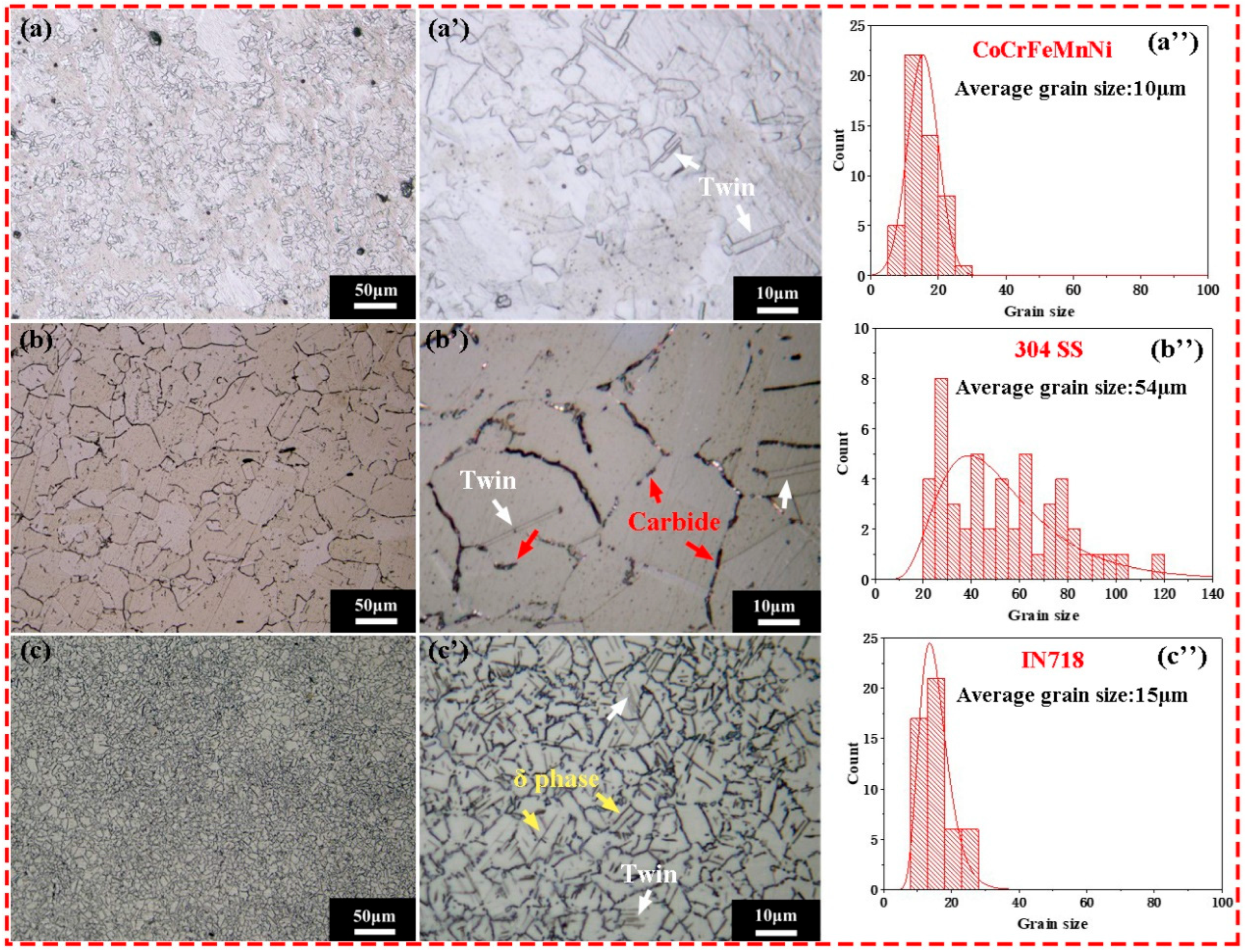
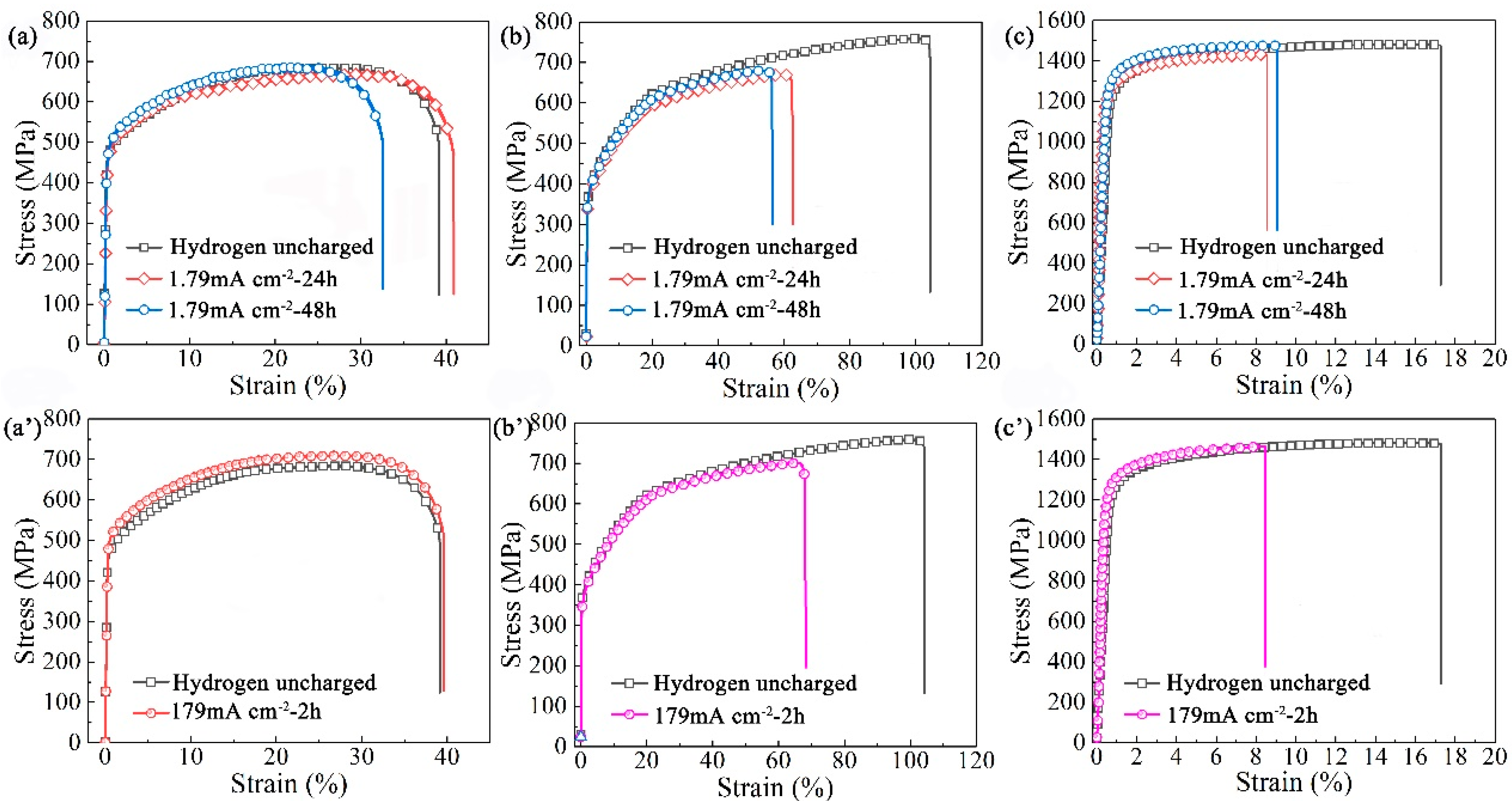


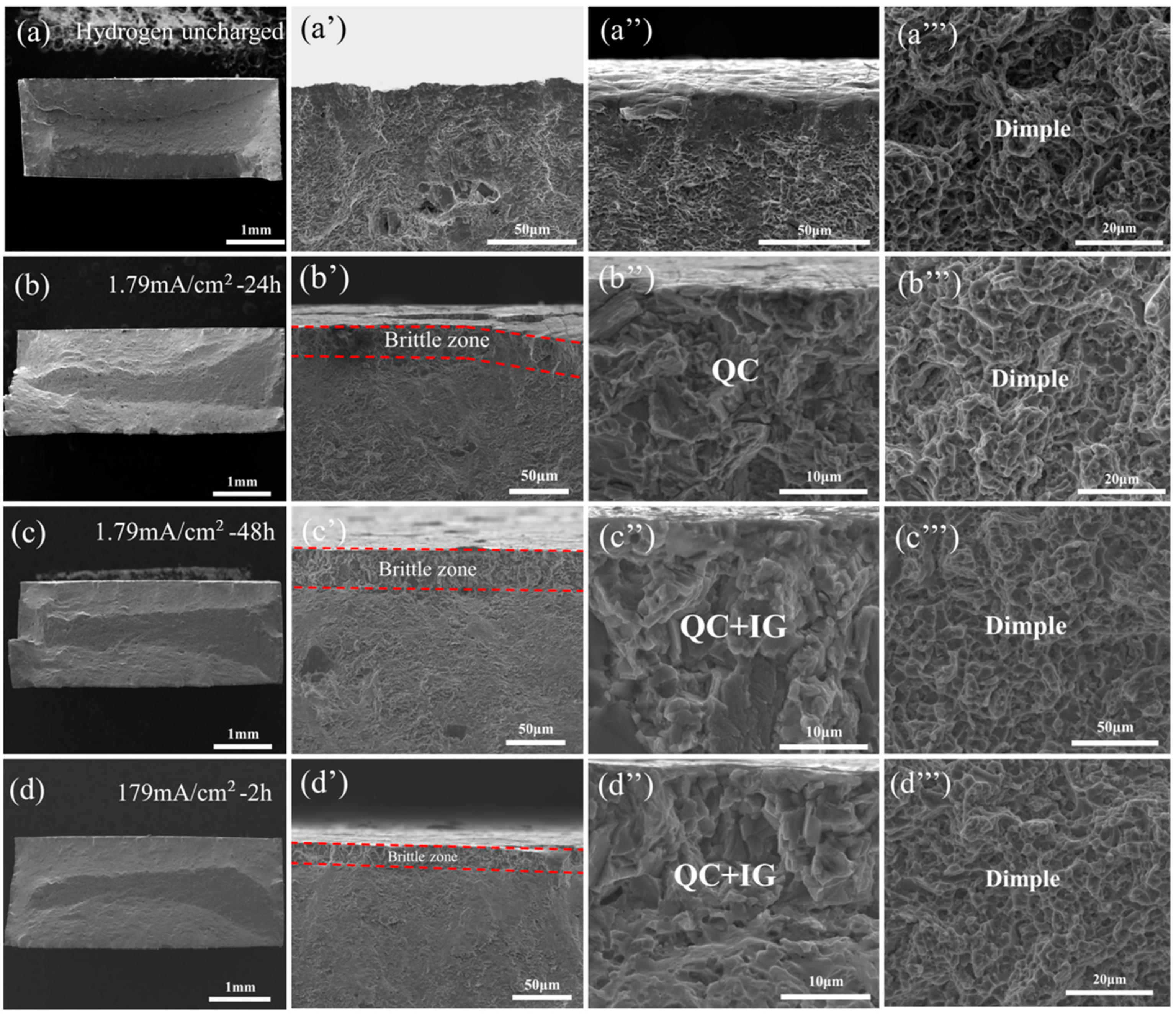
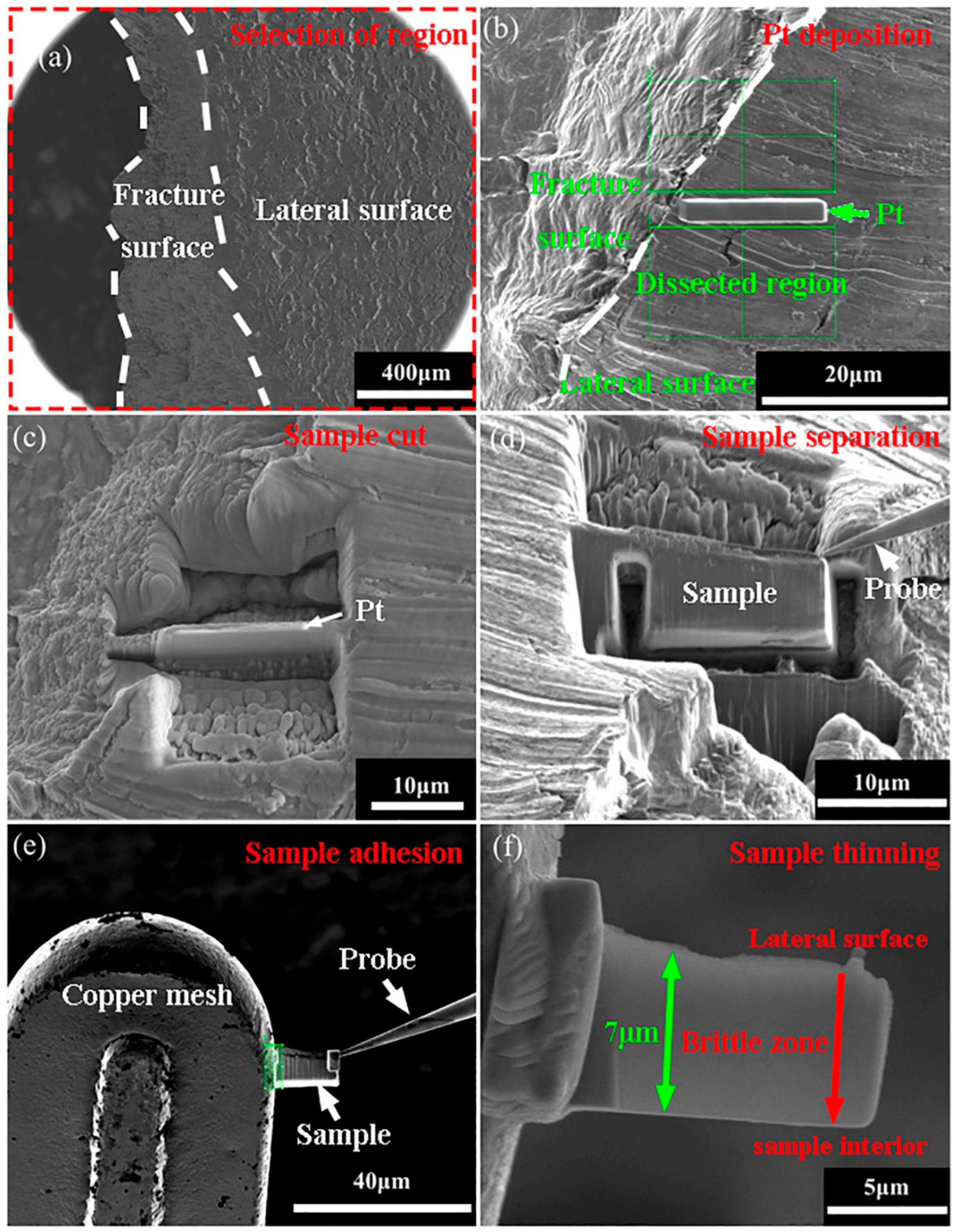
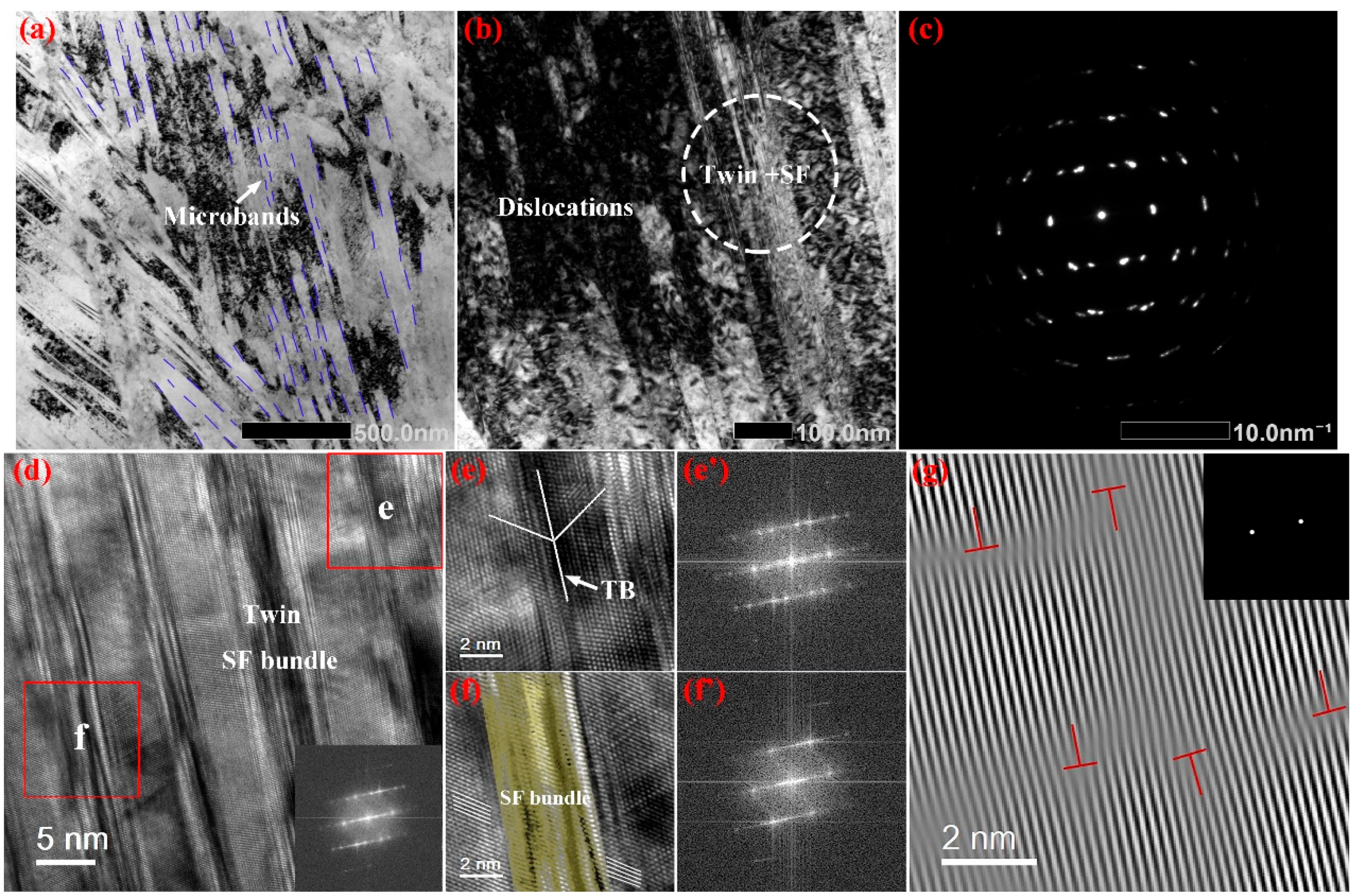
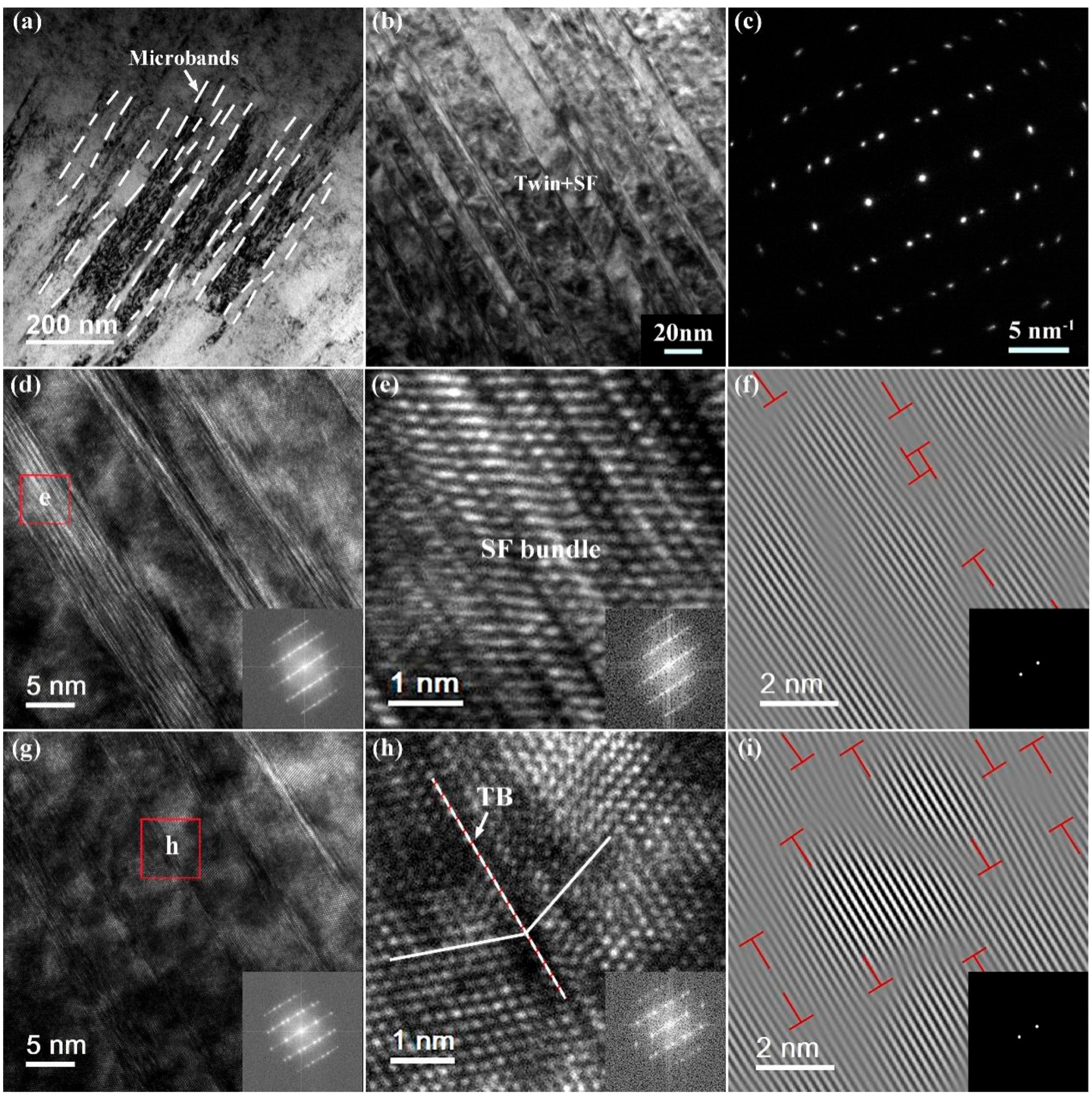

| Fe | Cr | Ni | Mn | Co | C | Mo | Si | S | P | Cu | Al | Ti | Nb | |
|---|---|---|---|---|---|---|---|---|---|---|---|---|---|---|
| HEA | 19.92 | 18.54 | 20.93 | 19.59 | 21.02 | |||||||||
| 304SS | Bal. | 19.06 | 8.15 | 1.01 | 0.045 | 0.016 | 0.5 | 0.012 | 0.031 | 0.019 | ||||
| IN718 | 19.2 | 18.75 | Bal. | 0.028 | 3 | 0.078 | 0.49 | 0.97 | 5.35 |
| Material | Hydrogen Charging | Tensile Strength (MPa) | Yield Strength (MPa) | Fracture Strain (%) | Reduction in Area (%) | HEI (%) |
|---|---|---|---|---|---|---|
| CoCrFeMnNi | 0 | 684 | 463 | 39 | 71 | |
| 1.79 mA cm−2—24 h | 672 | 471 | 41 | 74 | −3.86 | |
| 1.79 mA cm−2—48 h | 691 | 468 | 33 | 68 | 4.38 | |
| 179 mA cm−2—2 h | 709 | 493 | 39 | 72 | −0.98 | |
| 304SS | 0 | 759 | 340 | 104 | 0.56 | |
| 1.79 mA cm−2—24 h | 670 | 342 | 63 | 0.43 | 23.21 | |
| 1.79 mA cm−2—48 h | 679 | 345 | 57 | 0.38 | 32.20 | |
| 179 mA cm−2—2 h | 701 | 344 | 68 | 0.45 | 19.64 | |
| IN718 | 0 | 1481 | 1176 | 17 | 0.19 | |
| 1.79 mA cm−2—24 h | 1344 | 1261 | 8 | 0.10 | 47.37 | |
| 1.79 mA cm−2—48 h | 1476 | 1295 | 9 | 0.11 | 42.11 | |
| 179 mA cm−2—2 h | 1464 | 1222 | 15 | 0.12 | 36.84 |
| Hydrogen Charging Parameters | Brittle Zone Depth (μm) | ||
|---|---|---|---|
| CoCrFeMnNi | 304SS | IN718 | |
| 1.79 mA cm−2—24 h | 15.31 ± 1.0 | 31.74 ± 1.5 | 24.84 ± 1.0 |
| 1.79 mA cm−2—48 h | 19.57 ± 0.5 | 36.77 ± 3.0 | 24.88 ± 0.6 |
| 179 mA cm−2—2 h | 12.31 ± 0.8 | 29.40 ± 0.8 | 16.37 ± 0.4 |
| Hydrogen Charging Parameters | Brittle Zone Area Fraction (%) | ||
|---|---|---|---|
| CoCrFeMnNi | 304SS | IN718 | |
| 1.79 mA cm−2—24 h | 3.54 | 5.93 | 3.86 |
| 1.79 mA cm−2—48 h | 4.57 | 6.39 | 3.91 |
| 179 mA cm−2—2 h | 3.71 | 5.12 | 2.56 |
Publisher’s Note: MDPI stays neutral with regard to jurisdictional claims in published maps and institutional affiliations. |
© 2022 by the authors. Licensee MDPI, Basel, Switzerland. This article is an open access article distributed under the terms and conditions of the Creative Commons Attribution (CC BY) license (https://creativecommons.org/licenses/by/4.0/).
Share and Cite
Feng, Z.; Li, X.; Song, X.; Gu, T.; Zhang, Y. Hydrogen Embrittlement of CoCrFeMnNi High-Entropy Alloy Compared with 304 and IN718 Alloys. Metals 2022, 12, 998. https://doi.org/10.3390/met12060998
Feng Z, Li X, Song X, Gu T, Zhang Y. Hydrogen Embrittlement of CoCrFeMnNi High-Entropy Alloy Compared with 304 and IN718 Alloys. Metals. 2022; 12(6):998. https://doi.org/10.3390/met12060998
Chicago/Turabian StyleFeng, Zheng, Xinfeng Li, Xiaolong Song, Tang Gu, and Yong Zhang. 2022. "Hydrogen Embrittlement of CoCrFeMnNi High-Entropy Alloy Compared with 304 and IN718 Alloys" Metals 12, no. 6: 998. https://doi.org/10.3390/met12060998






